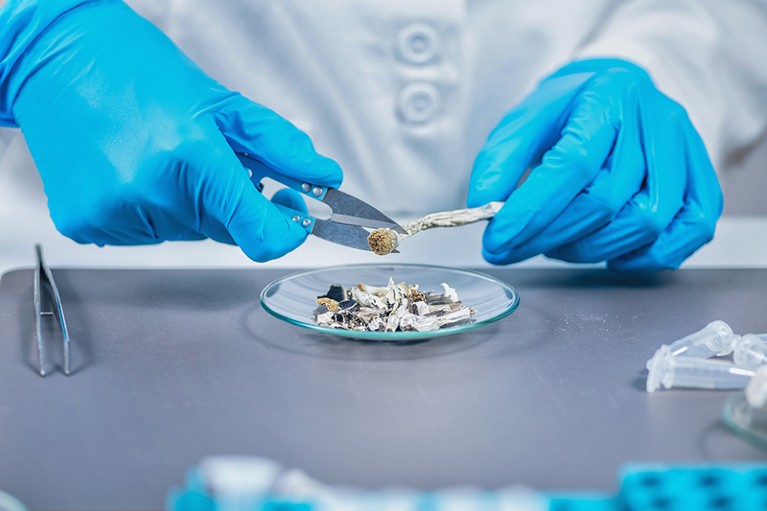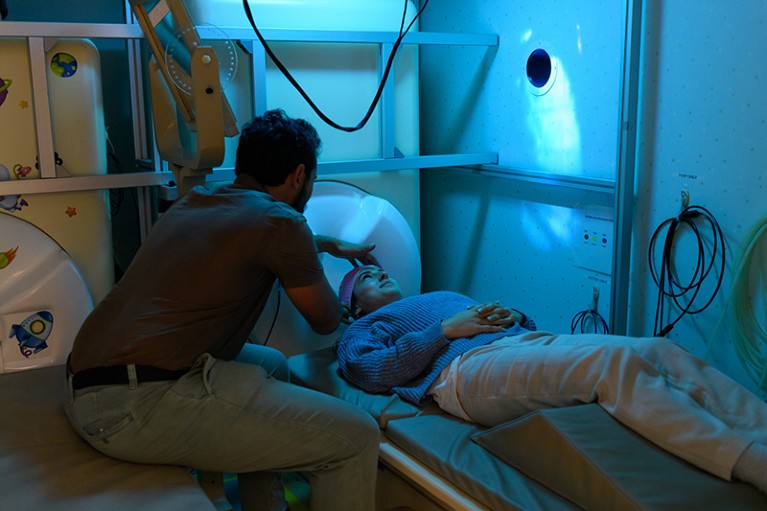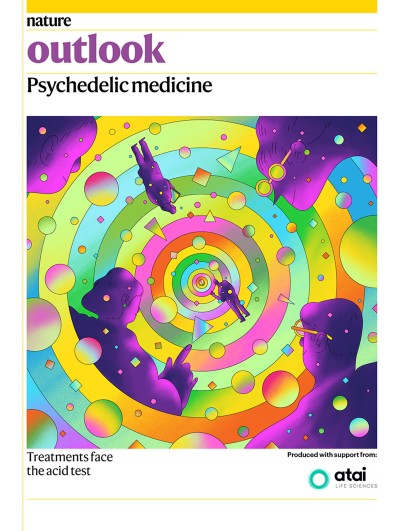
Magic mushrooms are cut into small pieces for studies of microdosing.Credit: Microgen/SPL/Getty
Not everyone who buys a psychedelic drug wants hallucinations — some of them are seeking therapeutic benefits. Microdosing, in which people regularly take small amounts of a psychedelic drug — typically about one-tenth of a recreational dose — has become popular in recent years. Proponents of the practice say they don’t experience any of the changes in consciousness that typify the recreational experience of a full dose. Instead, they claim a broad range of benefits, from improved mood to better sex lives.
There are plenty of scientific papers that chronicle these self-reported enhancements. In a 2019 study1, for example, 98 microdosers were asked daily questions over the course of six weeks to gauge their mindfulness, creativity, focus, happiness and productivity. They scored higher on each of the measures on days when they microdosed.
It is unclear whether these benefits exist beyond the placebo effect. One source of uncertainty is that people who microdose psychedelic substances usually have a specific hope for what it will achieve. As a result, some of the findings might be explained by the placebo effect. Even so, the self-reported benefits, coupled with promising results from full-dose studies, have prompted researchers to investigate the potential of microdosing to help form neurological connections in the brain, and mitigate the effects of psychological conditions such as depression, anxiety and attention-deficit hyperactivity disorder.
Too many variables
Separating the truth from the twaddle has so far proved to be quite a challenge for the scientists trying to verify microdosers’ claims. The main difficulty is pinning down the many variables that need to be accounted for if a study is to stand up to scrutiny.
“Which of all these disorders should we choose to test? For almost any problem that a person is struggling with, microdosing will allegedly help somehow,” says Harriet de Wit, a psychopharmacologist at the University of Chicago in Illinois. “It seems unlikely that one pharmaceutical product can do all that.”
Part of Nature Outlook: Psychedelic medicine
There is also the question of which drug to investigate, and at what dose. The psychedelic drugs most commonly discussed online for microdosing are LSD and psilocybin (the active ingredient in magic mushrooms). As for the dosage, a study2 of the posts in one forum with almost 200,000 subscribers found that most microdosers were taking between roughly 5% and 20% of a standard recreational dose. The frequency of doses also varied, although most posters said they take a two-day break between doses.
Online forums of this sort are not the most reliable sources of information, but that doesn’t mean that microdosing should be dismissed. It is not scientifically implausible — there are biological reasons to think that microdoses of psychedelics could have therapeutic potential, says de Wit. LSD, for example, might have anti-inflammatory properties that could address the chronic inflammation linked to depression.
“LSD’s mechanism of action is on serotonin, just like antidepressants,” she says. Any positive effects of microdosing, if they exist, are thought to accumulate gradually over time. This is another similarity with antidepressants, which don’t work immediately, says de Wit.
Studies have also shown that full doses of psychedelic drugs can be effective in relieving the symptoms of major depressive disorder. That provides a reasonable basis for hope that smaller quantities administered at regular intervals could also have an effect, says Peter Hunt, chair of Mind Medicine Australia, a non-profit organization based in Melbourne that supports research into psychedelic therapies for mental-health illnesses. “Remission rates in full-dose studies are encouraging, but the big unknown is how long these remissions last,” he says. Taking regular, smaller doses of the drug instead could help to keep things topped up, he suggests. “Where I think microdosing might end up helping is to prolong these remissions.”
Evidence for its efficacy, however, is still lacking. “We don’t really know if microdosing works yet,” says de Wit. “It’s our job as psychopharmacologists to figure it out.”
Proof or placebo?
One way to tackle the question is with the help of placebo-based trials, in which some participants are given a microdose of a psychedelic, and others are given an inactive substance. The evidence that is beginning to emerge from such studies, however, doesn’t look promising.
This year de Wit published a double-blind controlled study3 in which she examined the effects of four LSD microdoses administered three to four days apart. The size of the dose varied, with one group given 13 micrograms and another given double that. A third group received a placebo. The 56 participants, aged 18–35, answered hourly mood questionnaires for the first 5 hours after each dose. They also completed cognitive and behavioural tests after the first and final doses.
There were no significant differences between the three groups. “At the end we also asked participants what they thought they’d been given, and they weren’t very good at guessing,” says de Wit. Some people have sought to explain away the findings by criticizing the study’s methodology. “They can always say you didn’t give the drug to the right people, you didn’t give it for long enough, or you didn’t give the right dose,” de Wit says.
This could be true — it could be simply that de Wit and her team did not find the sweet spot for all these variables. “We don’t know exactly what to measure, because people have made such wild claims for microdosing,” she says. “That’s the biggest challenge.” Finding or ruling out such a sweet spot will require a lot more placebo trials involving many more combinations of variables.

Vince Polito prepares a participant for scanning in his study of psychedelic microdosing.Credit: Jesse Taylor, Macquarie Univ.
Vince Polito, a cognitive psychologist at Macquarie University in Sydney, Australia, thinks that should happen before scientists give up on the microdosing trend. “I’m certainly open to the possibility that it will all turn out to be nothing more than the placebo effect,” he says. “In the meantime, people who microdose are really sure that it works, and I think we scientists need to take it seriously.”
Others are more pessimistic. Balázs Szigeti, a researcher at Imperial College London’s Centre for Psychedelic Research, carried out what he says is the largest placebo-controlled microdosing trial so far, with 191 participants. His results also suggest that any microdosing benefits can be attributed to the placebo effect4. “When we started the study, our vision was that we’ll be the heroes to prove that microdosing works,” he says. “Our results were somewhat disappointing. The microdosing community was pretty bummed out.”
Quick and cheap
The study’s data were disappointing, but its unique methodology might nonetheless serve as a useful model for future work, by speeding up placebo-controlled trials. Szigeti took the unusual approach of recruiting existing microdosers to take part, and asked them to supply their own drugs for testing. Participants were asked to conceal the drugs they were using inside nondescript capsules, and to make up some identical-looking placebo capsules. The two types of capsule were then parcelled up into separate envelopes, marked with a code and shuffled, so only Szigeti and his colleagues knew which contained the psychedelic and which contained the placebo.
This self-blinded approach loses some of the precision of a classical lab-based study, however. “We weren’t as well controlled as normal trials,” says Szigeti. For example, it’s hard to know exactly what drugs and doses were used. But there were some notable benefits. Szigeti says he spent only about US$15,000 on the trial, which is very cheap for a clinical trial. “For a classic trial, you’re talking about several hundred thousand dollars,” he says. He also thinks the trial’s closeness to participants’ real-world practices is an advantage. “Clinical studies often become too far removed from reality and therefore the results can be artificial,” he says.
The speed of Szigeti’s approach is appealing, says de Wit. “Testing the subjects took us so much time, because we had them in for a five-hour duration each time they took a dose. It’s not something you do lightly, and I’m not sure I have the stamina to do it again right now,” she says. She isn’t willing to abandon the rigour that comes with a full clinical trial, but supports Szigeti and others taking different approaches. “The more data we collect in different ways, the better,” she says.
Too healthy
Szigeti thinks that the body of evidence is now turning away from psychedelic microdosing. “The book isn’t closed yet, but there have been enough negative results from different labs that it would be a bit weird if it did end up working,” he says.
More from Nature Outlooks
One last bastion of hope for microdosing’s proponents is the suggestion that scientists have been studying a population that is too healthy. “Maybe an effect is only evident when people have a depressive disorder or mood problem,” says Polito.
Szigeti is not convinced by that argument — roughly one-quarter of his participants had mild baseline depression before starting the trial, and they didn’t respond any differently from the rest of the cohort. But including some people with relatively mild mental-health issues is not the same as setting out to investigate microdosing in people being treated for more serious depression.
This is exactly what Polito aims to clarify in his next study. To find out whether the use of healthy participants is dampening the effects of microdosing in clinical trials, he plans to recruit at least 250 adults with moderate depression by the end of this year. Half the participants will take placebos and the other half will have two microdoses of psilocybin every week for six weeks. He intends to use 5 milligrams of the drug per dose. This is higher than the typical microdose, although it is still much lower than recreational doses, and stems from Polito’s worries that doses in previous trials might have been too low to produce an effect.
“If we don’t find positive results after this,” he says, “my enthusiasm will be dampened.”



